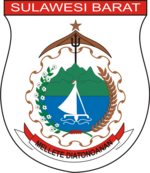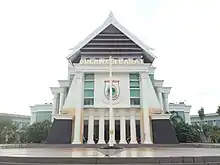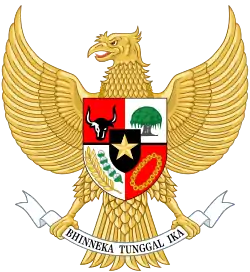West Sulawesi
West Sulawesi (Indonesian: Sulawesi Barat) is a province of Indonesia. It is located in the western of the Sulawesi island. It covers an area of 16,937.16 km2, and its capital is Mamuju. The 2010 Census recorded a population of 1,158,651, while that in 2015 recorded 1,279,994; the latest official estimate (as at 2019) is 1,536,115.[5]
West Sulawesi | |
|---|---|
 Flag  Coat of arms | |
| Motto(s): Mellete Diatonganan (Stick to the Truth) | |
 Location of West Sulawesi in Indonesia | |
| Coordinates: 2°41′S 118°54′E | |
| Established | 5 October 2004[1] |
| Capital | Mamuju |
| Government | |
| • Body | West Sulawesi Provincial Government |
| • Governor | Ali Baal Masdar |
| • Vice Governor | Enny Anggraeny Anwar |
| Area | |
| • Total | 16,937.16 km2 (6,539.47 sq mi) |
| Population (2019)[2] | |
| • Total | 1,536,115 |
| • Density | 91/km2 (230/sq mi) |
| Demographics | |
| • Ethnic groups (2010 census)[3] | 45.42% Mandar 12.49% Buginese 10.91% Mamasa 8.12% Mamuju 4.92% Javanese 4.38% Kaili 2.61% Pattae' 2.19% Makassarese 9.0% other |
| • Religion (2016)[4] | 82.2% Islam 14.8% Protestantism 1.47% Roman Catholicism 1.25% Hinduism 0.19% Folk 0.04% Buddhism 0.01% Confucianism |
| • Languages | Indonesian, Mandar, Mamasa, Bugis, Mamuju |
| Time zone | UTC+08 (CIT) |
| HDI | |
| HDI rank | 31st (2019) |
| Website | sulbarprov.go.id |
The province was established in 2004, having been split off from South Sulawesi.
Geography
It is on the island of Sulawesi (formerly Celebes) and includes the regencies (kabupaten) of Polewali Mandar, Mamasa, Majene, Mamuju, Central Mamuju and Pasangkayu (formerly called North Mamuju), which used to be part of South Sulawesi. The area of the province is 16,937.16 km2.
Economy
Its economy consists mainly of mining, agriculture and fishing. Its capital is Mamuju.
Archaeological findings
In 11 December 2019, a team of researchers led by Dr. Maxime Aubert announced the discovery of the oldest hunting scenes in prehistoric art in the world which is more than 44,000 years old from the limestone cave of Leang Bulu’ Sipong 4. Archaeologists determined the age of the depiction of hunting a pig and buffalo thanks to the calcite ‘popcorn’, different isotope levels of radioactive uranium and thorium.[6][7][8][9]
Administrative divisions

West Sulawesi Province is divided into six regencies:[10] Polewali Mandar, Mamuju, Pasangkayu, Mamasa, Majene, and Central Mamuju The sixth regency - Central Mamuju Regency (Kabupaten Mamuju Tengah) - was cut out of the existing Mamuju Regency on 14 December 2012.
Demographics
Its population at the 2010 census was 1,158,651 increasing at 2.67% annually. Of those 171,356 are classified as below the poverty line of Indonesia.[11]
Religion
| Regency/City | Islam | Protestant | Catholic | Hinduism | Buddhism | Confucianism/Konghucu | Folk |
|---|---|---|---|---|---|---|---|
| Majene | 99.75% | 0.10% | 0.10% | 0.02% | 0.03% | 0.00% | 0.00% |
| Mamasa | 20.29% | 70.80% | 4.35% | 2.92% | 0.01% | 0.01% | 1.62% |
| Mamuju | 81.61% | 16.61% | 0.87% | 0.88% | 0.02% | 0.01% | 0.00% |
| Central Mamuju | 80.24% | 12.90% | 2.18% | 4.57% | 0.10% | 0.01% | 0.01% |
| Pasangkayu | 86.98% | 6.99% | 1.83% | 4.19% | 0.01% | 0.01% | 0.00% |
| Polewali Mandar | 96.00% | 2.77% | 1.00% | 0.19% | 0.04% | 0.00% | 0.00% |
| West Sulawesi | 82.22% | 14.82% | 1.47% | 1.25% | 0.04% | 0.01% | 0.19% |
See also
References
- http://www.dpr.go.id/jdih/index/id/27
- Badan Pusat Statistik, Jakarta, 2019.
- Ananta, Aris; Arifin, Evi Nurvidya; Hasbullah, M Sairi; Handayani, Nur Budi; Pramono, Agus (2015). Demography of Indonesia's Ethnicity. Institute of Southeast Asian Studies. ISBN 978-981-4519-87-8. P. 102.
- Sulawesi Barat Dalam Angka 2016, BPS
- Badan Pusat Statistik, Jakarta, 2019.
- "Animal painting found in cave is 44,000 years old". BBC News. 2019-12-12. Retrieved 2020-04-26.
- "Narrative Cave Art in Indonesia Dated to 44,000 Years Ago | ARCHAEOLOGY WORLD". archaeology-world.com. Retrieved 2020-04-26.
- correspondent, Hannah Devlin Science (2019-12-11). "Earliest known cave art by modern humans found in Indonesia". The Guardian. ISSN 0261-3077. Retrieved 2020-04-26.
- "The oldest story ever told is painted on this cave wall, archaeologists report".
- 2010 Indonesian Census
- "Archived copy". Archived from the original on 2011-07-21. Retrieved 2010-12-08.CS1 maint: archived copy as title (link)
- "Population by Region and Religion in Indonesia". BPS. 2010.
